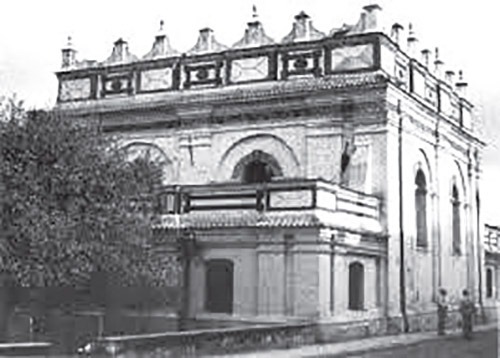


Poland, the place where the majority of the world’s Jewish population could be found by the eve of the First World War, was, of course, a land once dotted with thousands of Jewish houses of worship. Many of the original synagogues were constructed out of wood, others out of stone. No wooden synagogues survive from that period.
Before we get to the Jews and their synagogues, we must place some things in context.
The year is 1537 and a murder has taken place in Krakow. The unfortunate victim is an Italian architect by the name of Bartolommeo Berrecci; his alleged killer is another Italian architect. The motive: plain old jealousy. Berrecci had become wildly popular and quite wealthy, as many upper-class Poles commissioned his services. How did Poland, so far from home, become a dueling ground for ambitious Italians? To understand this, one must understand that Poland of that period was a booming center of trade, culture and architecture. It was the ideal place for architects and purveyors of culture to ply their trade and become wildly successful. It was particularly attractive to Catholics who would feel somewhat at home there—and some of whom would even go on to marry locals and settle there permanently.
Bernardo Morando, also known as Bernardino or Morandi (1540-1600), was just such a man. A native of Venice, he moved to Poland in 1569.
In 1578, he was commissioned by a fabulously wealthy Polish nobleman named Jan Zamoyski to design a Renaissance-style “ideal city” on his family’s vast lands.
Zamoyski was impressed with what he saw during his tenure as a student at the Medical School of Padua. He wanted Morando to build him something similar, and build it he did. When the project was completed, Zamoyski wanted his new town of Zamosc to be populated by a multicultural mosaic of people. Italians, Greeks, Armenians and others settled there. He expressly forbade, however, local Ashkenazi Jews from settling in the town, instead inviting Sephardim from the Kingdom of Venice and the Ottoman Empire—whom he considered cosmopolitan and culturally superior.
The preference of Sephardim over Ashkenazim continued after Zamoyski’s death when his heir and successor Thomas requested to extend the 1588 injunction for newly arrived Sephardic settlers from Flanders and Holland.
From the writ in the many injunctions there is also evident the faint hope that these Sephardim would prove to be a source of emulation for their “backward” Ashkenazic brethren.
Alexander Guterman, in his Hebrew article “Sefardim al Admat Polin,” cites a rare list of Sephardic heads of households from Zamosc, dated 1588-1650.
Appended to some of the names are some interesting details. For instance: Solomon Marcus and Avraham Mizrahi arrived from Venice. Yehuda Zakuta is described as a “Jewish native of the sephardic nation.” Efraim Kastiel was likewise born in Sepharad. Hanna Campus Italica, it is pointed out, married a local Ashkenazi man named Yaakov Bar. Samuel Jakubowitz (obviously polonized) appears to have arrived to Zamocz from Constantinople. Meshulam Cohen is called “turcicus” (the Turk). Other documents and tombstones reveal the name of at least one spiritual head of the community: Michael Doktor.
From a different list of Portuguese Sephardic poor people sent to settle in Poland from Amsterdam in 1752, a member of the rabbinic Uziel family (from Amsterdam) is found. This is interesting, as in the list of original settlers of Zamosc (cited above), a Abraham Uziel (slavicized to “Uzelowicz”) is found. It seems logical to conclude that they were sent to the Sephardic community of Zamosc and that the community was perhaps still somewhat flourishing at so late a date.
Interestingly enough, some of these families of Sephardic extraction were still found as late as the eve of World War II (Kastel, for instance). The famous Yiddish writer Y.L. Peretz was likewise a Zamosc native and a scion of “ashkenazified” Sephardim who settled the area.
Zamoyski’s vision of creating in Zamocz a center of scholarship and trade never came to fruition. Likewise, his hope that Sephardic Jews would continue to settle there and swell the ranks of the community never occurred either. However, what we do have are remnants of an ambitious if failed experiment.
To be continued…
By Joel S. Davidi Weisberger
Joel S. Davidi Weisberger runs the Jewish History Channel. Joel is also pursuing semicha at YCT while interning at Cong. Beth Tefillah at 452 Forest Ave. in Paramus, NJ, where you can catch his weekly dvar Torah after Mincha (this week at 4:45 p.m. Your help in the minyan would be greatly appreciated). Please feel free to write him at yoelswe@gmail.com.









